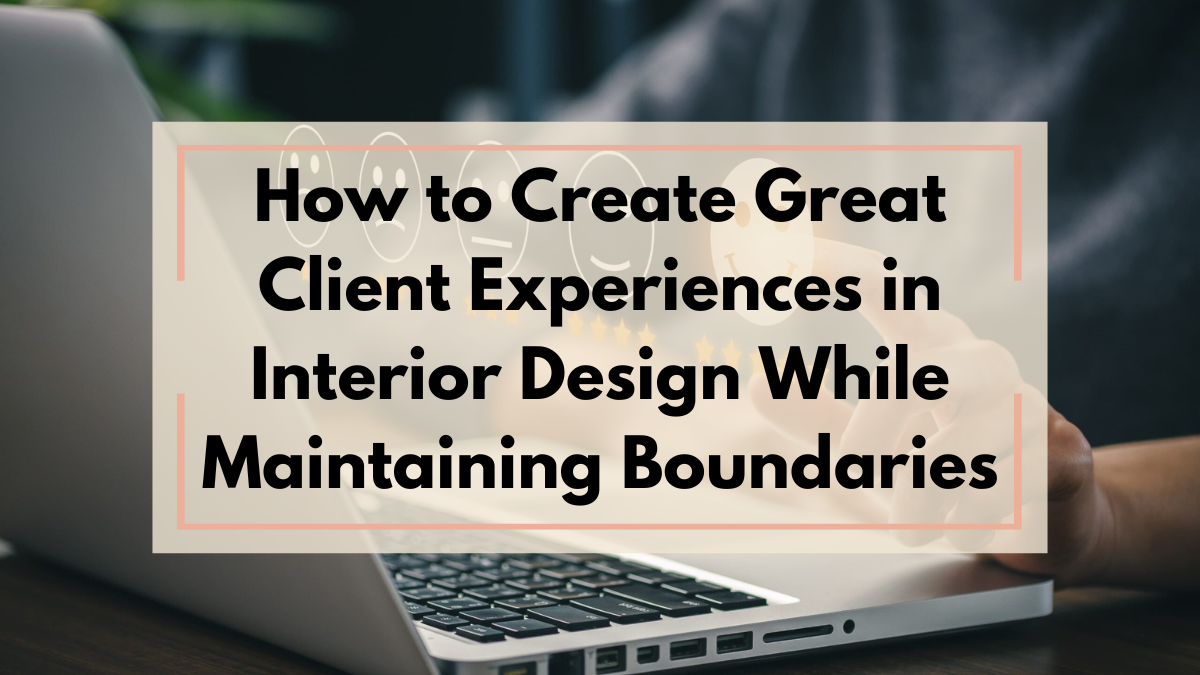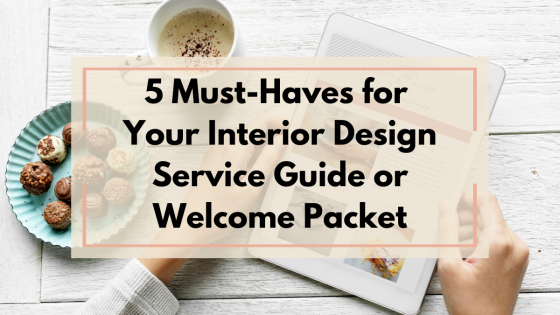How to Create Great Client Experiences in Interior Design While Maintaining Boundaries

The journey of an interior designer extends far beyond selecting beautiful furnishings and creating stunning spaces. At its core, this profession is about crafting experiences both in the environments you design and in the process, clients undergo while working with you. As your design business grows from a solo venture to a thriving practice, the delicate balance between exceptional client service and sustainable business practices becomes increasingly vital.
Many experienced designers find themselves caught in this tension—wanting to provide white-glove service while also protecting their time, creativity, and profitability. The good news is that exceptional client experiences and clear professional boundaries aren't opposing forces but complementary elements of a flourishing design business.
In this article, we'll explore how to craft memorable client journeys that turn your clients into enthusiastic advocates while simultaneously establishing the professional parameters that prevent scope creep, protect your well-being, and ensure sustainable growth. We'll uncover how the most successful design firms don't just deliver beautiful spaces, but they also orchestrate transformative experiences within well-defined frameworks that honor both the client's vision and the designer's expertise.
Creating the Exceptional Client Journey
#1. Mapping the Client Experience
The first step in elevating your client experience is understanding it from your client's perspective. Take time to map the entire journey from initial inquiry to project completion and beyond. This exercise reveals critical touchpoints where you can exceed expectations and identify potential friction points before they become issues.
- Begin by documenting each interaction a client has with your firm from discovering you on social media to the final reveal and follow-up.
- For each stage, consider the client's emotional state, questions they might have, and opportunities to delight them unexpectedly.
For example, after the initial consultation, many clients experience a mix of excitement and uncertainty. A thoughtfully curated welcome package that arrives the next day with the next steps clearly outlined, answers to frequently asked questions, and perhaps a small gift related to their project can ease anxiety and reinforce their decision to work with you.

#2. The Psychology of Memorable Experiences
What transforms a satisfied client into an enthusiastic advocate? Research on customer experience suggests that people remember peaks (high points), endings, and unexpected moments far more than the day-to-day interactions.Create intentional "peak moments" throughout your design process. This might include:
- An immersive presentation of concepts rather than simply emailing files.
- A mid-project gift that connects to their design vision.
- A champagne toast at installation.
These thoughtful touches create emotional high points that clients remember and share with others.Pay special attention to project conclusions. A beautifully photographed reveal, a personalized guidebook for maintaining their new space, or a thoughtful housewarming gift can create a memorable finale that leaves clients eager to refer you.
#3. Communication Excellence: The Foundation of Trust
Clear, consistent communication forms the bedrock of exceptional client experiences. Establish communication protocols that balance accessibility with boundaries from the outset.
Consider implementing a client communication rhythm that includes scheduled check-ins, progress updates, and decision deadlines. This proactive approach prevents clients from feeling the need to constantly check in while giving them confidence that their project is moving forward.
Utilize technology thoughtfully to enhance the client experience. Project management platforms like Asana, Monday, or design-specific tools like Design Manager can provide clients with appropriate visibility into their project while maintaining professional boundaries around your workflow.
67c07595362c0_lg.png)
Setting Professional Boundaries Without Compromising Service
#1. Reframing Boundaries as Client Benefits
Many designers hesitate to establish firm boundaries out of fear they'll be perceived as difficult or uncaring. The key is framing boundaries not as limitations but as structures that ensure exceptional outcomes.
For example, when explaining your communication policy of responding to client messages within 24 business hours rather than immediately, emphasize how this allows you to provide thoughtful, comprehensive responses rather than rushed answers. Similarly, when outlining your revision policy, explain how a structured approach to revisions results in more cohesive, well-considered designs than unlimited back-and-forth changes.
This perspective shift presents boundaries not as ways you're limiting service but as professional practices that ensure the highest quality results which is something every client wants.
#2. Creating Clear Agreements from Day One
The foundation for managing expectations and preventing scope creep begins with crystal-clear agreements before any design work commences. While contracts are essential, the way you present and explain these agreements shapes how clients perceive them.
- Develop a client onboarding process that includes a thorough review of your service agreement, highlighting not just what's included but also what's specifically excluded. Use concrete examples to illustrate scope boundaries: "Our full-service design includes three revision rounds for each room's design concept. Additional revisions can be accommodated for $X per round."
- Create visual aids that outline your design process, including client responsibilities and decision milestones. These visual roadmaps help clients understand how their timely decisions impact project timelines and outcomes.
67c0762b20f30_lg.png)
#3. The Art of the Graceful 'No'
Even with clear agreements, clients will occasionally request services beyond your scope. Learning to decline these requests professionally while preserving the relationship is an essential skill for growing your business.
Develop scripts for common scope expansion requests that offer alternatives rather than flat refusals. For instance, when a client asks for shopping assistance beyond what's included in their package, you might respond: "While additional shopping services aren't included in your current package, I'd be happy to add this service for $X. Alternatively, I can provide a detailed shopping list with links for you to purchase these items independently.
"Remember that saying "no" to scope creep allows you to say "yes" to delivering exceptional results within the agreed parameters, ultimately creating a better client experience.
Systems That Scale Without Sacrificing Personal Touch
#1. Systematizing the Special Touches
As your firm grows, maintaining consistent client experiences becomes challenging without proper systems. The goal is to systematize the predictable aspects of your service so you can personalize the moments that matter most.
- Create client experience frameworks that ensure consistency while allowing for personalization. For example, develop a standard welcome package template with space to include project-specific elements that speak to each client's unique vision.
- Document your signature client experiences as standard operating procedures that team members can follow. This might include guidelines for how consultations are conducted, presentation formats, or installation day protocols that create consistent "wow" moments regardless of which team member is leading the project.
#2. Team Training for Client Excellence
As you hire team members, their ability to deliver your brand of client experience becomes crucial. Invest time in training beyond just design skills to include client interaction standards.
- Develop communication guidelines that reflect your brand voice and values. Include sample scripts for handling common scenarios, from excited clients to challenging conversations about timeline delays or budget concerns.
- Consider creating a client experience playbook that documents not just what your team does at each project phase but how they do it - the tone, approach, and special touches that define your brand. This resource ensures new team members can quickly align with your client experience vision.
67c076bff3d87_lg.png)
#3. Technology That Enhances Human Connection
Leverage technology strategically to enhance rather than replace the personal aspects of your service. The right tech tools can handle routine communications and project management, freeing you and your team to focus on high-touch interactions.
- Implement automated but personalized check-ins at key project milestones. For example, an email template that your project manager customizes slightly before sending can maintain communication consistency while still feeling personal.
- Use client relationship management (CRM) systems to track client preferences, important personal details, and past conversations. This allows everyone on your team to maintain the personal connection you've established, even as the client interacts with different team members.
Maintaining Professionalism Through Challenging Situations
#1. When Expectations and Reality Diverge
Even with the best planning, situations will arise where client expectations don't align with project realities. These moments test your client experience systems and boundaries alike.
Develop a framework for addressing expectation gaps proactively. When you notice signs of misalignment—such as a client expressing surprise about the timeline or repeatedly requesting items outside the scope—schedule a reset conversation rather than letting frustration build.
Approach these conversations with curiosity rather than defensiveness, using phrases like "I notice we may have different expectations about X. Can we revisit our agreement to make sure we're aligned?" This collaborative framing prevents clients from feeling defensive while reinforcing the parameters you've established.
#2. The Power of Transparent Problem-Solving
How you handle inevitable project challenges often defines the client relationship more than when everything goes smoothly. Develop a transparent approach to problem-solving that involves clients appropriately without burdening them with every detail.
When issues arise, present them along with potential solutions rather than just the problem. For example, instead of saying "The sofa you selected is backordered for 12 weeks," say "The sofa you selected is backordered for 12 weeks. We have three options we can explore..." This approach demonstrates your professionalism while giving clients appropriate agency in decisions.
Document how your firm handles common challenges so your response remains consistent as you scale. This resource becomes invaluable as you bring on team members who will need to navigate similar situations.
Conclusion
Creating exceptional client experiences while maintaining professional boundaries isn't about choosing one over the other. It's about recognizing how these elements work in harmony to build a sustainable, scalable design business. The most successful interior designers understand that clear boundaries actually enhance client experiences by creating predictability, preventing disappointments, and allowing you to consistently deliver on your promises.
As you implement the strategies we've explored from mapping the client journey to creating memorable moments, establishing clear agreements, systematizing special touches, and navigating challenges professionally, remember that each element supports the others. Your detailed onboarding process sets expectations that make boundary maintenance easier later on. Your systematic approach to communication prevents misunderstandings that could strain relationships. Your thoughtfully designed client experience makes clients more understanding when you must enforce scope boundaries.
This integrated approach allows you to scale your business without sacrificing the personal touch that built your reputation. By creating frameworks for exceptional experiences rather than reinventing them with each client, you build a business that can grow beyond your personal capacity while maintaining the quality and care that defines your brand.
Thank you for reading ❤️
Categories: : Client Experience
 Rikaza Shakeer
Rikaza Shakeer 


